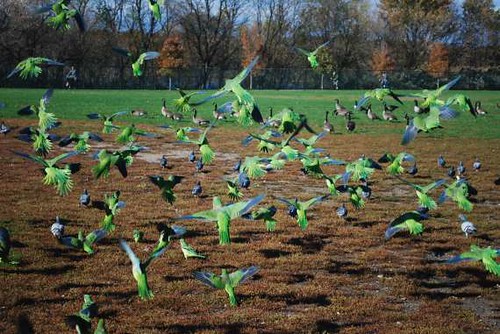 Quaker parrots in flight at Overpeck Park in Leonia. Image WAYNE NORRISLEONIA — It was hard to miss the tangled mass of twigs engulfing a transformer high atop a utility pole in Overpeck County Park on Fort Lee Road.
Quaker parrots in flight at Overpeck Park in Leonia. Image WAYNE NORRISLEONIA — It was hard to miss the tangled mass of twigs engulfing a transformer high atop a utility pole in Overpeck County Park on Fort Lee Road.
So when borough residents Wayne and Jenine Norris passed by last weekend they were shocked to see the massive nest was gone. As they looked closer, they found two broken eggs on the ground and realized that the colony of Quaker parrots, also called monk parakeets, was frantically trying to rebuild its home.
"My husband and I love the parrots," Jenine Norris said. "To see all the birds flying around in a panic, it kills you."
No one seems to know exactly how the exotic-looking birds came to New Jersey, where they've come to call Leonia, Edgewater and Ridgefield home and continue to expand their colonies each year. One theory is that they escaped from a shipping crate at John F. Kennedy Airport in the 1960s, flew to Brooklyn and eventually settled in Edgewater, which appears to have the largest population in North Jersey.
Norris' husband, who often photographs the birds, which are bright green with blue-tipped wings, immediately thought someone had removed the nest as an act of animal cruelty.
But it was actually a routine removal by Public Service Electric and Gas. In addition to removing two nests in the borough — the other was on Grand Avenue near Sylvan Park — PSE&G also took down about 30 nests on and near River Road in Edgewater last week.
"We have to remove the nests each spring to ensure the integrity of the electrical system," company spokeswoman Bonnie Sheppard said.
The nests can be as large as 4 feet long and a foot wide, she said, adding that experienced employees carefully remove them with guidance and permits from the state Division of Fish and Wildlife.
Sheppard and Leonia Councilman Gil Hawkins, an environmentalist and executive director of the Overpeck Park Preserve, said the birds, which do not migrate during the winter, build their nests on transformers because of the heat the equipment emits.
But Sheppard said the nests can cause problems.
"Nests often damage electrical equipment by engulfing the electrical devices, blocking ventilation," she said. "Resulting trapped heat can cause devices to short-circuit, leading to local power failures."
Hawkins said he hates to see the birds displaced, but understands why PSE&G removes the nests.
"As an environmentalist, I hate to see any nesting bird get hurt, but on the other hand, they are an invasive species," he said.
But there are benefits to having the birds, like the spectators they bring to the park, Hawkins said.
"They are such an attractive bird, many people really stop and look at them," he said. "Children are amazed by them."
Legislation sought
Pet stores are barred from selling them, as the Division of Fish and Wildlife considers them a "potentially dangerous species due to the possibility of becoming agricultural pests."
But in the decades that they've been here, Alison Evans-Fragale, founder of Edgewater Parrots, which advocates for the protection of the birds, argues they have not been a threat to other species or agriculture.
She has pushed for state legislation to remove the "potentially dangerous" classification and require state and local government to protect the birds.
The bill was first introduced in 2004 and an online petition supporting it garnered 2,751 signatures. It didn't get far at first, but was reintroduced in 2006, was approved by the Assembly Agriculture and Natural Resources Committee, and got the Assembly's unanimous stamp of approval. It was then sent to the Senate for consideration, but didn't make it out of the Environmental Committee before the legislative session ended, killing the bill.
Since that time it was reintroduced by local sponsors in 2008 and 2010 but never made it out of committee again.
The measure has not yet been introduced this session, but Wayne Norris said he would like to see the effort revived.
"We should be happy that the parrots are in our area and we should protect them," he said.
Steps have been taken to do just that. Evans-Fragale worked with PSE&G to make sure the timing of the removal does not harm the birds or their eggs.
"The procedure is to try to remove the nests before breeding season," Sheppard said. "We found no eggs or fledglings in any of the nests we took down in Edgewater."
Janine Norris said it was possible the eggs she and her husband found were not a result of the nest removal, or that the birds laid eggs earlier this year because of the unseasonably warm weather. Either way she said it was a heartbreaking sight.
One alternative is installing artificial nesting platforms, she said.
In 2010, when work was slated to begin on the Hendricks Causeway bridge in Ridgefield where a colony of the parakeets had built nests on the steel abutments, Evans-Fragale and members of the Ridgefield Environmental Commission worked with the contractor to safely relocate the birds. Joe Cosimairo of Power Concrete Co. in Newark had his crews build two wooden boxes on unused utility poles adjacent to the bridge so the birds could build new nests while the work was under way.
Since the birds often relocate where their previous nests were, Norris said it makes sense to install the platforms, which would protect the eggs and the birds. In recent days she said the colony at Overpeck County Park has been frantically rebuilding.
"They are working their darndest," she said. "I feel so bad that they are stressed out."